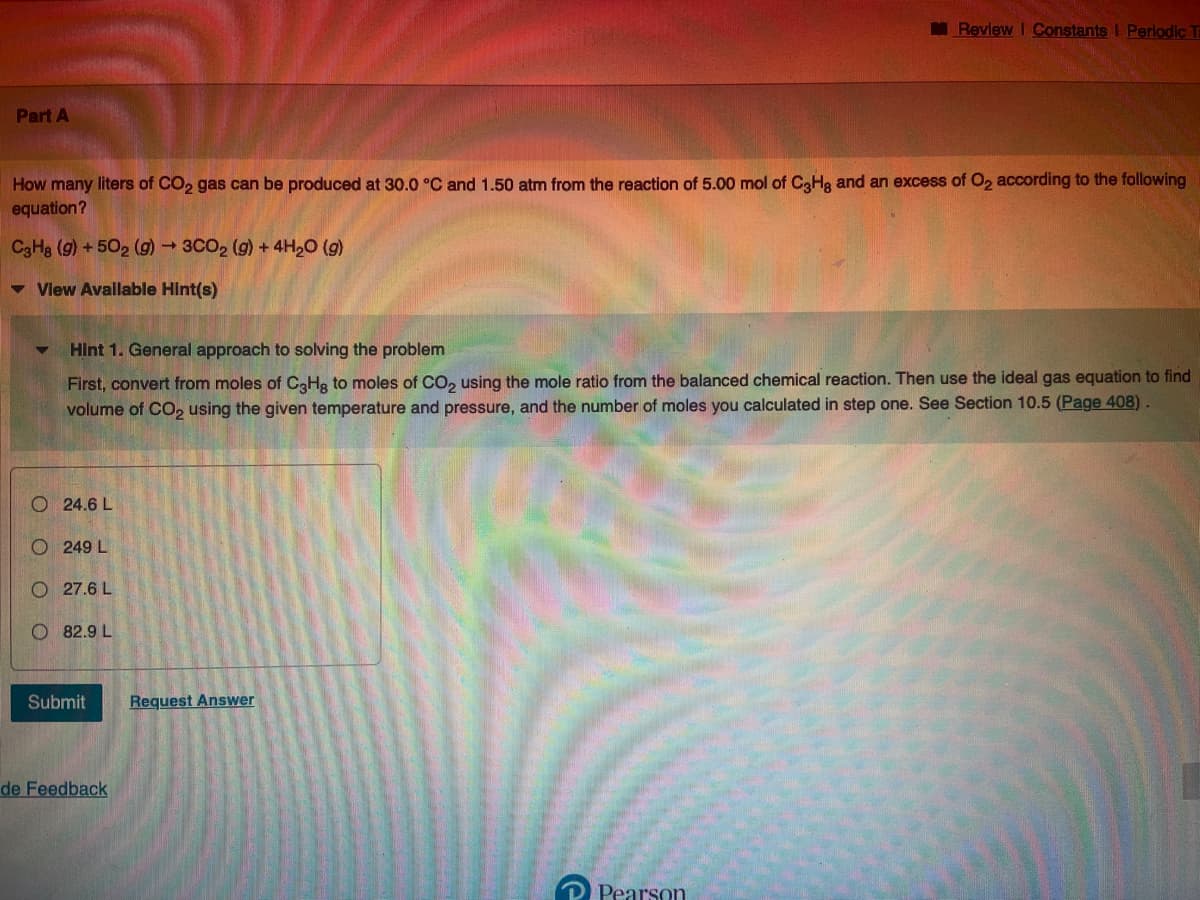How many liters of CO2 gas can be produced at 30.0 °C and 1.50 atm from the reaction of 5.00 mol of C3Hg and an excess of O₂ according to the following equation? C3H8 (9) +502 (g) → 3CO2 (g) + 4H₂O(g) View Available Hint(s) Hint 1. General approach to solving the problem First, convert from moles of C3Hg to moles of CO₂ using the mole ratio from the balanced chemical reaction. Then use the ideal gas equation to firm volume of CO₂ using the given temperature and pressure, and the number of moles you calculated in step one. See Section 10.5 (Page 408).
How many liters of CO2 gas can be produced at 30.0 °C and 1.50 atm from the reaction of 5.00 mol of C3Hg and an excess of O₂ according to the following equation? C3H8 (9) +502 (g) → 3CO2 (g) + 4H₂O(g) View Available Hint(s) Hint 1. General approach to solving the problem First, convert from moles of C3Hg to moles of CO₂ using the mole ratio from the balanced chemical reaction. Then use the ideal gas equation to firm volume of CO₂ using the given temperature and pressure, and the number of moles you calculated in step one. See Section 10.5 (Page 408).
Chemistry
10th Edition
ISBN:9781305957404
Author:Steven S. Zumdahl, Susan A. Zumdahl, Donald J. DeCoste
Publisher:Steven S. Zumdahl, Susan A. Zumdahl, Donald J. DeCoste
Chapter5: Gases
Section: Chapter Questions
Problem 162CP
Related questions
Question
100%

Transcribed Image Text:Part A
How many liters of CO₂ gas can be produced at 30.0 °C and 1.50 atm from the reaction of 5.00 mol of C3Hg and an excess of O₂ according to the following
equation?
C3Hg (g) +502 (g) → 3CO2 (g) + 4H2O(g)
▾ View Available Hint(s)
▼ Hint 1. General approach to solving the problem
First, convert from moles of C3Hg to moles of CO2 using the mole ratio from the balanced chemical reaction. Then use the ideal gas equation to find
volume of CO₂ using the given temperature and pressure, and the number of moles you calculated in step one. See Section 10.5 (Page 408).
O24.6 L
O249 L
O27.6 L
82.9 L
Submit
de Feedback
Review | Constants I Periodic T
Request Answer
Pearson
Expert Solution
This question has been solved!
Explore an expertly crafted, step-by-step solution for a thorough understanding of key concepts.
Step by step
Solved in 2 steps with 2 images

Knowledge Booster
Learn more about
Need a deep-dive on the concept behind this application? Look no further. Learn more about this topic, chemistry and related others by exploring similar questions and additional content below.Recommended textbooks for you

Chemistry
Chemistry
ISBN:
9781305957404
Author:
Steven S. Zumdahl, Susan A. Zumdahl, Donald J. DeCoste
Publisher:
Cengage Learning

Chemistry: An Atoms First Approach
Chemistry
ISBN:
9781305079243
Author:
Steven S. Zumdahl, Susan A. Zumdahl
Publisher:
Cengage Learning


Chemistry
Chemistry
ISBN:
9781305957404
Author:
Steven S. Zumdahl, Susan A. Zumdahl, Donald J. DeCoste
Publisher:
Cengage Learning

Chemistry: An Atoms First Approach
Chemistry
ISBN:
9781305079243
Author:
Steven S. Zumdahl, Susan A. Zumdahl
Publisher:
Cengage Learning


General Chemistry - Standalone book (MindTap Cour…
Chemistry
ISBN:
9781305580343
Author:
Steven D. Gammon, Ebbing, Darrell Ebbing, Steven D., Darrell; Gammon, Darrell Ebbing; Steven D. Gammon, Darrell D.; Gammon, Ebbing; Steven D. Gammon; Darrell
Publisher:
Cengage Learning

Chemistry by OpenStax (2015-05-04)
Chemistry
ISBN:
9781938168390
Author:
Klaus Theopold, Richard H Langley, Paul Flowers, William R. Robinson, Mark Blaser
Publisher:
OpenStax

Chemistry for Engineering Students
Chemistry
ISBN:
9781337398909
Author:
Lawrence S. Brown, Tom Holme
Publisher:
Cengage Learning